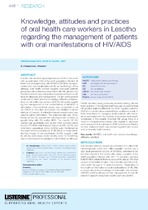Knowledge, attitudes and practices of oral health care workers in Lesotho regarding the management of patients with oral manifestations of HIV/AIDS
Abstract
Lesotho has the third highest prevalence of HIV in the world
with an estimated 23% of the adult population infected. At
least 70% of people living with HIV/AIDS (PLWHA) have presented
with oral manifestation of HIV as the first sign of the
disease. Oral health workers regularly encounter patients
presenting with oral lesions associated with HIV disease and
therefore need to have adequate knowledge of these conditions
for diagnosis and management. The aim of the present
study was to determine the knowledge, attitudes and practices
of oral health care workers (OHCW) of Lesotho regarding
the management of oral manifestations of HIV/AIDS. A
descriptive cross-sectional survey was conducted on all
46 OHCW in 26 public and private care facilities in all ten
districts of Lesotho. A self - administered questionnaire was
used to gather information. The response rate was 100%.
Nearly all (94.7%) agreed that oral lesions are common in
people living with HIV and/or AIDS. The majority (91.3%)
named oral candidiasis (OC) as the most common lesion
found in PLWHA while Kaposi's Sarcoma (KS) (34.7%) and
Oral Hairy Leukoplakia (OHL) (32.6%) were mentioned as
the least common oral lesions of HIV. Most correctly identified
the images of oral candidiasis (97.8%), angular cheilitis
(86.9%) and herpes zoster (80.4%). Only 16.7% felt they
had comprehensive knowledge of oral HIV lesions, although
84.8% reported having previously received training. Almost
three quarters (71%) reported that there was no need to treat
HIV positive patients differently from HIV negative patients.
OHCW in Lesotho demonstrated high confidence levels in
their competence in managing dental patients with oral lesions
associated with HIV, however, they lacked an in-depth
knowledge in this regard. Amongst this group there is a
need for comprehensive training with regards to diagnosis
and management of oral lesions of HIV including the training
of other cadres of health care workers together with nurses
and community health workers.

